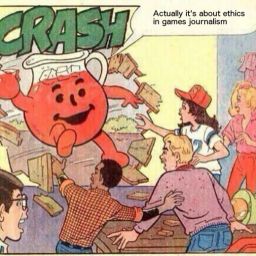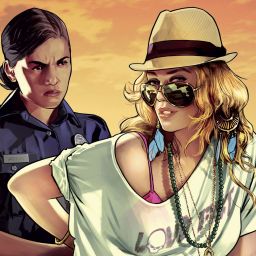by Kristin Bezio
I know Flower (2009) was released several years ago now, but our household just acquired a PlayStation 4 (PS4), so now is the first time I’ve been able to actually play it. Flower was made by the same folks who made Fl0w (2006), which you can play or download (partially) for free online. I like Fl0w for a lot of reasons, and I assumed Flower would be similar.
One of the great things about Fl0w is that the narrative is highly abstract and very opaque. As a player, you have to figure out who/what you are and how to play almost entirely on your own. There is no dialogue, no exposition, only art, sound, and mechanics. In that sense, Flower is more of the same; however, where Fl0w’s narrative is all-but-absent, Flower is as transparent as the pane of glass in its opening window.
Transparency is not in and of itself a bad thing. A certain amount of transparency is, in fact, generally a good thing. In narrative, though, sometimes too much transparency can leave a reader/viewer/player feeling as though they’ve been slapped with an ideological wet fish, and, sadly, Flower is a little bit like that. It’s also beyond idealistic, which, when mixed with said transparency, left me with a feeling of irritation rather than triumph (or any motivation to address the issue at hand).
That said, Flower is a fun way to kill several hours. The music is pleasant, the colors and general artscape of the game are beautiful, and if you can get the hang of using the controller’s gyroscopic control scheme, it’s actually fairly relaxing.
spoilers below
In Flower, you play as a series of flower petals. The game begins with a lonely potted flower waiting to bloom on the windowsill of a dingy urban apartment. Each level in fact begins with a different potted flower on the same windowsill (there are six total, and they make a rainbow). Each level begins with a scene from urban life, complete with dingy background in grey and brown tones, the sounds of traffic and sirens, and a gloomy sense of urban industrialized oppression.
The first several levels transport the player to an idyllic pastoral scene with one flower which ejects a single petal, controlled by the player. That petal flies around the landscape making contact with other flower-buds, which then open and add petals to a growing train following in the wake of the original petal. When enough flowers have been opened in a specific area, they make the brownish-tan grass turn green, cause other flowers to grow, and transform the landscape.
By the time I’d opened the first set of three flowers, I’d already figured out that this game was about how the industrialized urban world needed to reconnect with nature in order to transform from depressing and dirty into beautiful and joyful. I was not wrong.
As the player progresses, the “day” moves into twilight (level three), and wind turbines appear in the environment—the first human-made structures in the flower-petal part of the game. Now opening flowers enables the turbines to turn, sending the petals across the landscape. In level four things change. It is nighttime, and the petals create glowing blue flowers. Enough of these in an area actually turns on lights (now there are electrical wires with bulbs, the occasional streetlight, and a few other human-made structures).
The last of these in level four shorts out, the yellow lights turn red, and the music becomes angry and dark. Obviously, human-made structures are now bad, an allusion to the problems of industrialization—as in the game, the introduction of electricity in the nineteenth century led to the rapid spread of human machinery and the Industrial Revolution. Industrialization—the production of electricity from fossil fuels, the spread of human transportation across the globe, and factory manufacturing—is the primary impetus for human-caused environmental destruction, and is becoming an increasing cause of global warming and pollution as more and more current third-world countries seek to industrialize in order to raise the standards of living for their people. In the meantime, industrialized countries (like the U.S.) don’t bother to curtail their own emissions and contributions to pollution, leading to a downward environmental spiral.
This is what the game is getting at. Everything is all pretty and sparkling until we learn how to turn on the lights, and then things get out of control. In level five (whose potted flower is half-wilted), the player’s petals can actually be damaged and burned by touching the structures that now make up much of the play environment. In this level, opening the few blue flowers shifts the lights from red to orange, and makes the structures they power safe for the petals to touch. Unlike in other levels, where flowers were plentiful, there are only blue and white flowers in this level, and they are hard to find or hard to get to without touching the electrified structures.
At the end of this level, the player activates the petal-train (which honestly seems to me more like a Chinese parade dragon—the giant puppets with multiple people inside—made of petals, although I’m not sure why) in order to smash through some struts at the end.
This shifts to the final level, in which the game’s environmental message turns from grim to Polyanna. In this level, the player is in a city instead of a natural environment, and the petals fly around smashing ugly struts as well as opening new flowers. As struts are smashed and new flowers open, the grass turns green and the roads and buildings are scrubbed shiny and clean and colorful, instead of black and grey.
Yup, some pretty flowers make everything all utopian and wonderful! And that’s where I really got annoyed. Without this final level, the game’s point is clear and obvious, but doesn’t cross over into the ridiculous. In level six, it presents this idealistic belief (accompanied by happy triumph music) that if we just live in harmony with the pretty flowers, we can make a perfect city that is both urban and natural—we just have to destroy the industrial complex and plant some trees and flowers in order to do so.
And that’s just eye-rollingly simplistic. Would it work as a message for kids? Probably. But to me, it just becomes too obvious and too oblivious to the complexities of living in a modern age. In the final transition back to the window-menu, the game seems to suggests that it knows this, as the urban environment it shows is not the shiny vision from the flower-world, but a more realistic image of a clean city (complete with a wall covered in graffiti—nice graffiti—using the creature from Fl0w) with green space and happy children and sunshine.
Nevertheless, this kind of simplicity is dangerous; it lets us feel good about having done something little (like recycling a can) to help the environment while over-representing the good that does (recycling a can when you drive a gas-guzzling car, leave all your lights on, and purchase all your water in plastic bottles is so simplistic it’s silly). In order to send a meaningful message, we can’t over-represent our altruism (having some flowers in pots) as making a difference; we have to be honest with ourselves and in our media if we actually want to inspire some real change.






[…] Well, our household finally decided it was time to purchase a PlayStation product (PS4), so I now have access to other thatgamecompany games, like Journey (soon) and Flower. So I finally played Flower, and here’s why I thought. […]